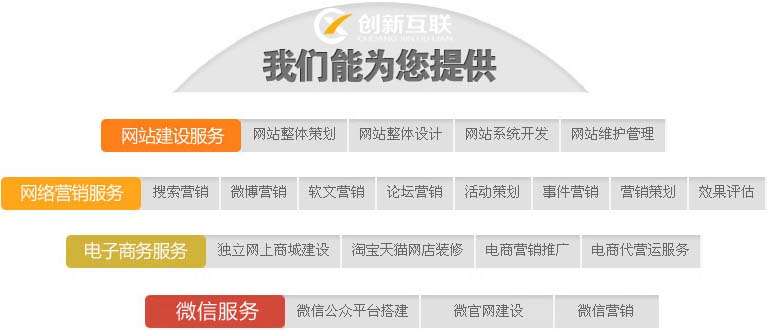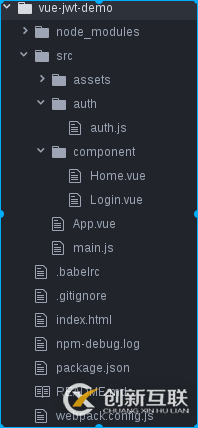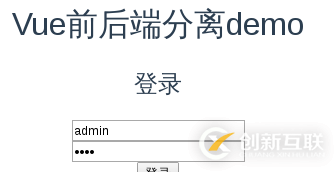前后端分離之VueJS前端的示例分析-創(chuàng)新互聯(lián)
這篇文章給大家分享的是有關(guān)前后端分離之VueJS前端的示例分析的內(nèi)容。小編覺(jué)得挺實(shí)用的,因此分享給大家做個(gè)參考,一起跟隨小編過(guò)來(lái)看看吧。

前言
前端用什么框架都可以,這里選擇小巧的vuejs。
要實(shí)現(xiàn)的功能很簡(jiǎn)單:
1、登錄功能,成功將服務(wù)器返回的token存在本地
2、使用帶token的header訪問(wèn)服務(wù)器的一個(gè)資源
本次實(shí)驗(yàn)環(huán)境:
"dependencies": {
"vue": "^2.2.1"
},
"devDependencies": {
"babel-core": "^6.0.0",
"babel-loader": "^6.0.0",
"babel-preset-latest": "^6.0.0",
"cross-env": "^3.0.0",
"css-loader": "^0.25.0",
"file-loader": "^0.9.0",
"vue-loader": "^11.1.4",
"vue-template-compiler": "^2.2.1",
"webpack": "^2.2.0",
"webpack-dev-server": "^2.2.0"
}開(kāi)發(fā)IDE:Atom
首先建一個(gè)項(xiàng)目
使用webpack構(gòu)建
/Atom# vue init webpack-simple vue-jwt-demo ... /Atom# cd vue-jwt-demo/ /Atom/vue-jwt-demo# cnpm install /Atom/vue-jwt-demo# npm run dev
安裝插件
/Atom/vue-jwt-demo# cnpm install vue-router /Atom/vue-jwt-demo# cnpm install vue-resource
整體目錄

auth.js
完成token的存取
const SERVER_URL = 'http://localhost:8081'
const LOGIN_URL = SERVER_URL+'/login2'
export default{
data:{
authenticated:false
},
login(context,info){
context.$http.post(LOGIN_URL,info).then(function(data){
console.log(data.bodyText)
localStorage.setItem('token',data.bodyText);
this.authenticated = true
//跳到home頁(yè)
this.$router.push('home')
},function(err){
console.log(err+","+err.body.message)
context.error = err.body.message
})
},
getAuthHeader(){
return {
'Authorization':'Bearer '+localStorage.getItem('token')
}
},
checkAuth(){
var token = localStorage.getItem('token')
if(token){
this.authenticated = true
}else{
this.authenticated = false
}
}
}main.js
程序入口:完成路由和初始化
import Vue from 'vue'
import App from './App.vue'
import Login from './component/Login.vue'
import Home from './component/Home.vue'
import VueRouter from 'vue-router'
import VueResource from 'vue-resource'
import auth from './auth/auth'
Vue.use(VueRouter)
Vue.use(VueResource)
//在啟動(dòng)APP時(shí)進(jìn)行校驗(yàn)是否有token
auth.checkAuth()
const routes= [
{
path:'/',redirect:'/login'
},
{
path:'/login',component:Login
},
{
path:'/home',component:Home
}
]
const router = new VueRouter({
routes
})
new Vue({
router,
render: h => h(App)
}).$mount('#app')App.vue
頁(yè)面載體
<template>
<div id="app">
<h2>{{msg}}</h2>
<router-view></router-view>
</div>
</template>
<script>
export default {
name: 'app',
data () {
return {
msg: 'Vue前后端分離demo'
}
}
}
</script>Login.vue
登錄頁(yè)面
<template>
<div>
<h3>登錄</h3>
<p>{{ error }}</p>
<div>
<input
type="text"
placeholder="Enter your username"
v-model="info.username"
>
</div>
<div>
<input
type="password"
placeholder="Enter your password"
v-model="info.password"
>
</div>
<button @click="submit()">登錄</button>
</div>
</template>
<script>
import auth from '../auth/auth'
export default {
data() {
return {
info: {
username: '',
password: ''
},
error: ''
}
},
methods: {
submit() {
var info = {
username: this.info.username,
password: this.info.password
}
auth.login(this, info)
}
}
}
</script>效果:丑是丑了點(diǎn)

Home.vue
主頁(yè)面,訪問(wèn)一個(gè)獲取郵箱的請(qǐng)求
<template>
<div id="home">
<h2>{{msg}}</h2>
<button @click="getEmail()">Get Email</button>
<h3>Email:{{email}}</h3>
</div>
</template>
<script>
import auth from '../auth/auth'
export default {
name: 'home',
data () {
return {
msg: '歡迎您登錄成功',
email:''
}
},
beforeCreate(){
//如果沒(méi)有token的話需要重新登錄
if(!auth.authenticated){
this.$router.push('login')
}
},
methods:{
getEmail(){
this.$http.get('http://localhost:8081/user/getEmail',{
headers:auth.getAuthHeader()
}).then(function(re){
this.email = re.bodyText
},function(){
console.log("get email error")
})
}
}
}
</script>
<style>
#app {
font-family: 'Avenir', Helvetica, Arial, sans-serif;
-webkit-font-smoothing: antialiased;
-moz-osx-font-smoothing: grayscale;
text-align: center;
color: #2c3e50;
margin-top: 60px;
}
h2, h3 {
font-weight: normal;
}
a {
color: #42b983;
}
</style>對(duì)應(yīng)在服務(wù)端:
@GetMapping("/getEmail")
public String getEmail() {
return "xxxx@qq.com";
}
可看到瀏覽器的本地存儲(chǔ):

感謝各位的閱讀!關(guān)于“前后端分離之VueJS前端的示例分析”這篇文章就分享到這里了,希望以上內(nèi)容可以對(duì)大家有一定的幫助,讓大家可以學(xué)到更多知識(shí),如果覺(jué)得文章不錯(cuò),可以把它分享出去讓更多的人看到吧!
另外有需要云服務(wù)器可以了解下創(chuàng)新互聯(lián)建站www.chinadenli.net,海內(nèi)外云服務(wù)器15元起步,三天無(wú)理由+7*72小時(shí)售后在線,公司持有idc許可證,提供“云服務(wù)器、裸金屬服務(wù)器、高防服務(wù)器、香港服務(wù)器、美國(guó)服務(wù)器、虛擬主機(jī)、免備案服務(wù)器”等云主機(jī)租用服務(wù)以及企業(yè)上云的綜合解決方案,具有“安全穩(wěn)定、簡(jiǎn)單易用、服務(wù)可用性高、性?xún)r(jià)比高”等特點(diǎn)與優(yōu)勢(shì),專(zhuān)為企業(yè)上云打造定制,能夠滿足用戶(hù)豐富、多元化的應(yīng)用場(chǎng)景需求。
當(dāng)前題目:前后端分離之VueJS前端的示例分析-創(chuàng)新互聯(lián)
當(dāng)前地址:http://www.chinadenli.net/article10/dpjpdo.html
成都網(wǎng)站建設(shè)公司_創(chuàng)新互聯(lián),為您提供搜索引擎優(yōu)化、營(yíng)銷(xiāo)型網(wǎng)站建設(shè)、云服務(wù)器、App設(shè)計(jì)、手機(jī)網(wǎng)站建設(shè)、網(wǎng)站策劃
聲明:本網(wǎng)站發(fā)布的內(nèi)容(圖片、視頻和文字)以用戶(hù)投稿、用戶(hù)轉(zhuǎn)載內(nèi)容為主,如果涉及侵權(quán)請(qǐng)盡快告知,我們將會(huì)在第一時(shí)間刪除。文章觀點(diǎn)不代表本網(wǎng)站立場(chǎng),如需處理請(qǐng)聯(lián)系客服。電話:028-86922220;郵箱:631063699@qq.com。內(nèi)容未經(jīng)允許不得轉(zhuǎn)載,或轉(zhuǎn)載時(shí)需注明來(lái)源: 創(chuàng)新互聯(lián)
猜你還喜歡下面的內(nèi)容
- 四川云服務(wù)器哪個(gè)品牌好-創(chuàng)新互聯(lián)
- 瀏覽器的內(nèi)核怎么分布-創(chuàng)新互聯(lián)
- python實(shí)現(xiàn)代數(shù)式括號(hào)有效性檢驗(yàn)-創(chuàng)新互聯(lián)
- 解決瀏覽器顯示”SSL證書(shū)無(wú)效”的方法-創(chuàng)新互聯(lián)
- java多線程自學(xué)linux應(yīng)該學(xué)哪些內(nèi)容呢?-創(chuàng)新互聯(lián)
- 大數(shù)據(jù)有哪些基本特征-創(chuàng)新互聯(lián)
- 手動(dòng)備份MySQL數(shù)據(jù)庫(kù)的教程-創(chuàng)新互聯(lián)

- 行業(yè)軟件開(kāi)發(fā)遇到問(wèn)題該如何解決 2022-07-18
- APP軟件開(kāi)發(fā)時(shí)間寶APP,明星碎片化時(shí)間也能共享? 2022-06-24
- APP開(kāi)發(fā)制作:醫(yī)療APP軟件開(kāi)發(fā)移動(dòng)端解決方案 2020-11-21
- 關(guān)于軟件開(kāi)發(fā),老板不知道的6件事 2021-05-12
- 初學(xué)Java軟件開(kāi)發(fā),須熟練掌握的核心技術(shù) 2016-08-17
- 成都軟件開(kāi)發(fā)企業(yè)定制軟件只是一個(gè)開(kāi)始 2022-05-28
- 如何確定軟件開(kāi)發(fā)公司的APP開(kāi)發(fā)的價(jià)格 2022-06-19
- 我們?yōu)槭裁匆獙W(xué)習(xí)php軟件開(kāi)發(fā)? 2016-08-15
- 人工智能的發(fā)展會(huì)不會(huì)全面取代軟件開(kāi)發(fā)崗位 2016-08-22
- 善用管理工具,提高軟件開(kāi)發(fā)項(xiàng)目質(zhì)量 2016-08-29
- 手機(jī)app軟件開(kāi)發(fā)對(duì)企業(yè)和創(chuàng)業(yè)者有什么意義? 2016-08-05
- 成都軟件開(kāi)發(fā)解析SEO是否需要每天寫(xiě)原創(chuàng)文章 2022-05-30